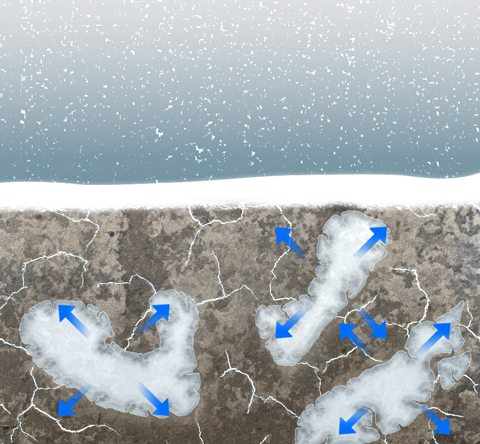Source: Journal of Geophysical Research: Earth Surface
A loud bang startled residents on the outskirts of the city of Oulu, Finland, on the evening of 6 January 2016, immediately followed by tremors that created large cracks in a nearby road and building. A research station 14 kilometers away recorded seismic events that indicated a small earthquake near Earth’s surface—an unusual event in tectonically stable Finland.
But the shaking wasn’t caused by shifting plates or volcanic activity. Instead, a unique set of winter conditions acted together to create a frost quake, which occurs when large amounts of water contained within soil rapidly freeze. Because water expands when it freezes, the ice exerts pressure on the surrounding soil and bedrock, which have lost much of their elasticity because of the cold conditions. With enough force from the ice, the ground violently fractures.

The frost quake in Oulu was one of the first to be recorded in an urban area, providing valuable information for researchers trying to understand what causes them. In a new study, Okkonen et al. used these data to model the environmental conditions leading up to frost quakes to predict when and where they might occur in the future.
Their results indicate a narrow range of conditions that, taken together, are conducive to the formation of frost quakes, including a sudden drop in temperatures that are initially at or close to freezing (0°C).
“Whenever an area with fully saturated soils experiences a sharp decrease in temperature, the ice underground will rapidly expand,” said Jarkko Okkonen, a geoscientist at the University of Oulu and lead author on the study.
“The process is similar to freezing a jar full of water. When there’s no more room for the ice to expand, the pressure it exerts will ultimately exceed the strength of the jar, and the glass will crack.”
Snow cover is also likely to be present, as water from snowmelt results in high soil moisture content. A thick layer of snow, however, reduces the chances of frost quakes by providing insulation that keeps water and ice within the soil at a more regulated, albeit chilly, temperature.
The day of the quake in Oulu, the ground had been covered by only a thin layer of insulating snow, and the quake had been directly preceded by a sudden drop in temperature.
“The process is similar to freezing a jar full of water,” said Okkonen. “When there’s no more room for the ice to expand, the pressure it exerts will ultimately exceed the strength of the jar, and the glass will crack.”
A Common Phenomenon, Rarely Observed
Frost quakes are thought to be fairly common in boreal regions around the world, but because they often occur in sparsely populated areas, determining the exact environmental conditions that lead to their occurrence has been difficult.
The 2016 Oulu frost quake happened to occur at the end of a long-term environmental monitoring study in central Finland, which the scientists at the University of Oulu used to create their model.
“We had been collecting data using temperature and soil water probes between 2011 and 2015 at a site with similar soils to the area where the frost quake occurred in 2016,” said Okkonen.
Okkonen hopes to fine-tune the model’s parameters by incorporating even more data and performing lab-based experiments.
“We still aren’t sure which types of soil are most conducive to the formation of frost quakes, so that’s the next thing we’d like to look at,” said Okkonen. (Journal of Geophysical Research: Earth Surface, https://doi.org/10.1029/2020JF005616, 2020).
—Jerald Pinson (@jerald_pinson), Science Writer
Citation:
Pinson, J. (2020), Predicting the Next Big Frost Quake, Eos, 101, https://doi.org/10.1029/2020EO151183. Published on 30 October 2020.
Text © 2020. AGU. CC BY-NC-ND 3.0
Except where otherwise noted, images are subject to copyright. Any reuse without express permission from the copyright owner is prohibited.
Text © 2020. AGU. CC BY-NC-ND 3.0
Except where otherwise noted, images are subject to copyright. Any reuse without express permission from the copyright owner is prohibited.

